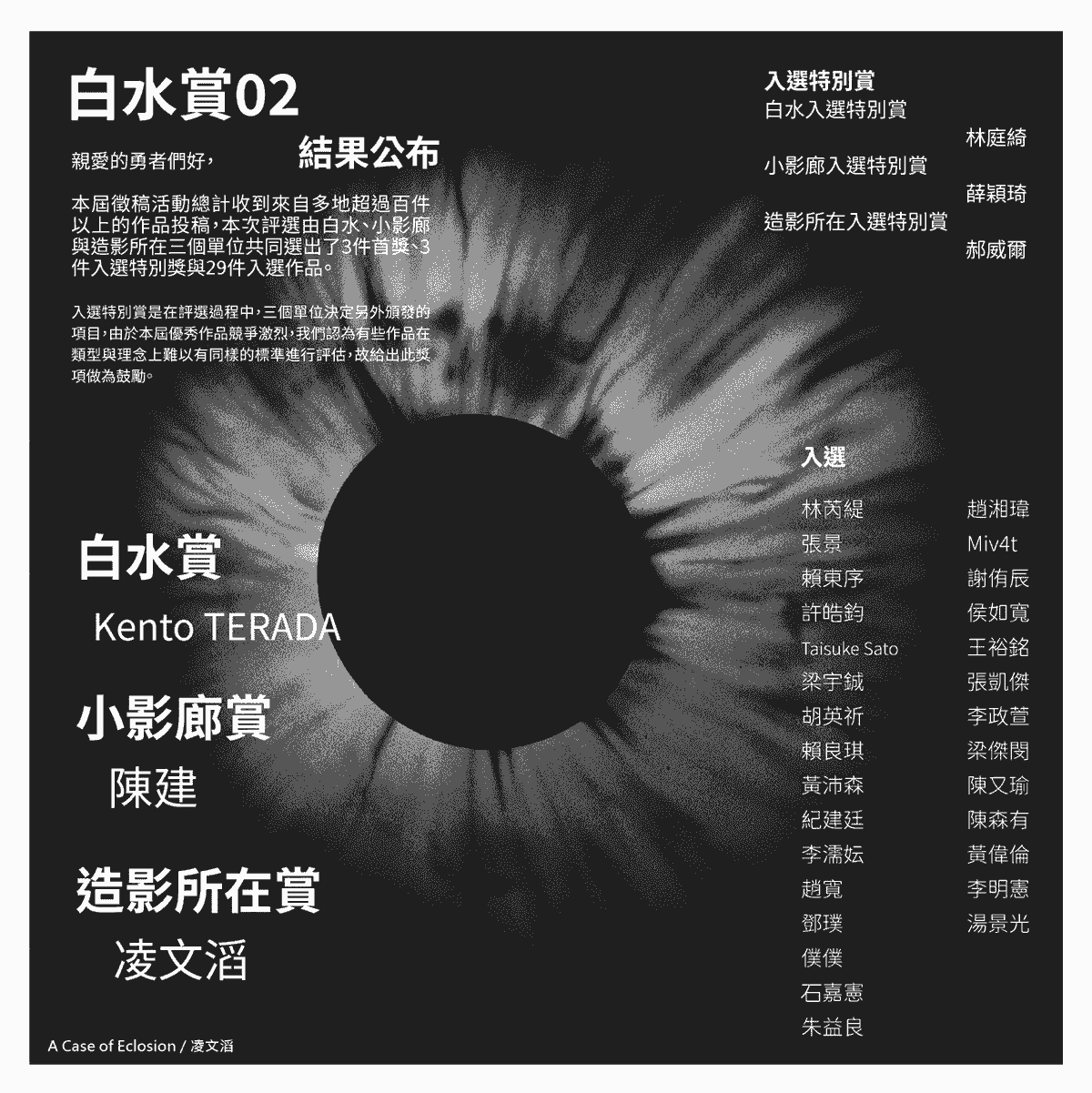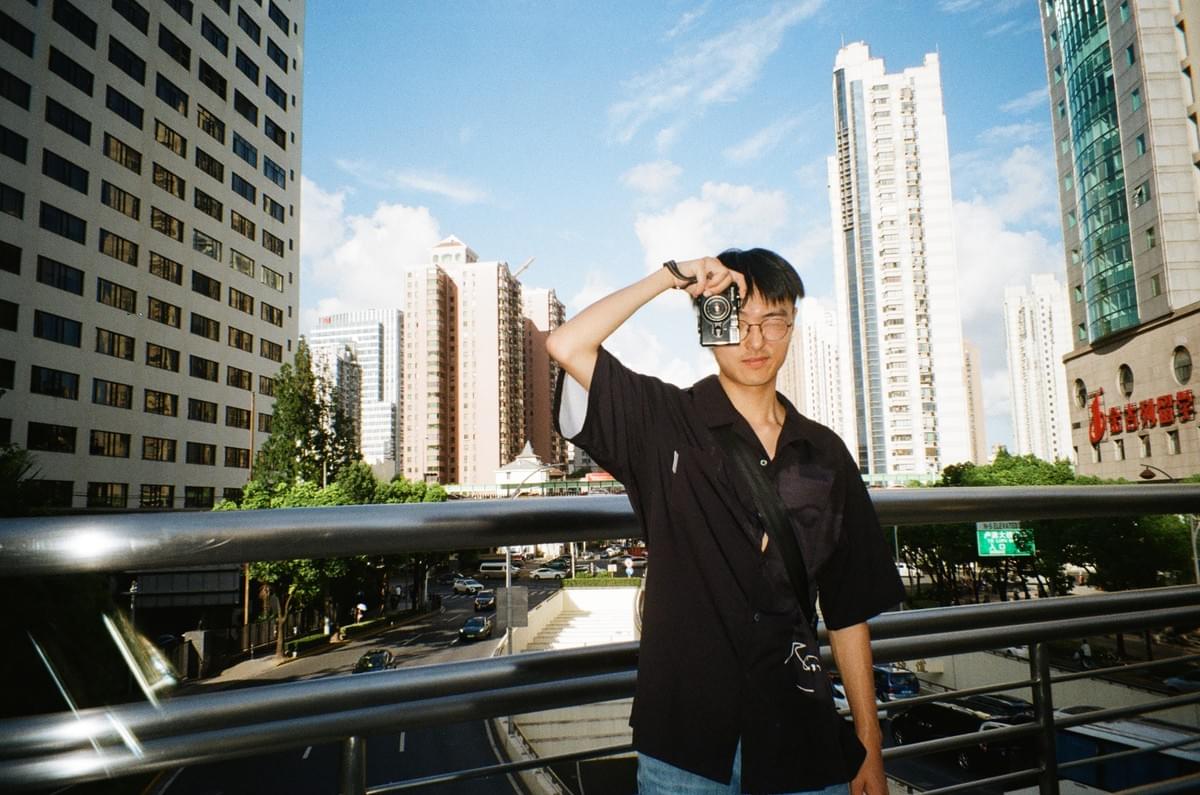

白水賞 SpringBao Award 02
白水賞02 結果公布

白水賞02 結果 : Kento TERADA & 陳建 & 凌文滔
親愛的勇者們好,
本屆活動總計收到來自多地超過百件以上的作品投稿,本次評選由白水、小影廊與造影所在三個單位共同選出了3件首獎、3件入選特別獎與29件入選作品。
白水賞
Kento TERADA
living with my imaginary wife and little girl
小影廊賞陳建
黎明在手心,永恆在手背
造影所在賞凌文滔
「A Case of Eclosion」
白水入選特別賞
林庭綺/入海口
小影廊入選特別賞
薛穎琦/光の彼岸
造影所在入選特別賞
郝威爾/浮游
入選
林芮緹/你看這個拿相機的怪人
張景/Routine Colony
賴東序/藍領
許皓鈞/一段車程
Taisuke Sato/まなざし的追溯
梁宇鋮/水土
胡英祈/未知的刺痛 (Twinges of Unknown)
賴良琪/他假裝在自己的記憶裡探險
黃沛森/國家公僕
紀建廷/風光明媚
李濡妘/短暫的敘事
趙寬/Somewhere after dark
鄧璞/在霧散之後
僕僕/貓
石嘉憲/台灣怪譚
朱益良/天光日Tien` Gong` Ngid
趙湘瑋/浮生若夢
Miv4t/夢與虛實
謝侑辰/「燃 | 山海經」
侯如寬
王裕銘/愛的幻覺
張凱傑/soft glitch
李政萱/下班之後
梁傑閔/基礎練習
陳又瑜/不可逆轉 Irreversible
陳森有/路過的風
黃偉倫/6EQUJ5(Wow Signal)
李明憲/無明
湯景光/觸點
*入選特別賞是在評選過程中,三個單位決定另外頒發的項目,由於本屆優秀作品競爭激烈,我們認為有些作品在類型與理念上難以有同樣的標準進行評估,故給出此獎項做為鼓勵。
*同時有鑑於本屆活動優秀作品眾多,經三個單位評估後決定多舉辦一個入選者聯展,讓入選者也能展示自己的作品給公眾,期待引起更多交流與討論。
個展與聯展日期:
白水賞、小影廊賞、造影所在賞個展
2026.01.09 ~ 2026.02.08
2026.01.10 開幕活動
白水賞02入選者聯展
2026.02.20 ~ 03.08
2026.02.28 聚會活動
*各單位開放參觀時間以各單位公告為主
最後,本屆白水賞02的所有參加者都可以獲得由造影所在提供的兩張藝術微噴明信片作為參加獎,明信片的索取請在白水賞個展與白水賞聯展期間(1/9~3/8前)到白水領取。
*白水的開放時間: 每週四至週日 13:00-18:00 (週六至20:00)

白水賞01 獲獎者 - 謝雨潼/捷克風景
謝雨潼是一名攝影師,1999 年出生於雲南省曲靖市。他的實踐聚焦於空間的探索, 關注空間中的人類活動,以及歷史,社會,政治對空間留下的痕跡。在布拉格電影學院學習期間,他進行了多種媒介的探索,透過錄影,裝置,現成圖片等媒介,討論身份,政治,遷徙,以及親密關係。
捷克風景
捷克人總會自豪地說,自己在歐洲的心臟。他們不位於東歐,而是中歐。中間是捷克的位置,在開放和保守之間,在歡愉和傷痛之間,在蘇聯和美國之間。捷克共和國就像斯柯達轎車,它運作良好,但是在大眾汽車和LADA汽車之間。中心的另一重意義是邊緣。在西歐的邊緣,也在東歐的邊緣。邊緣是地理界限的概念,也是一種無形的處境。從慕尼黑協定到布拉格之春,捷克斯洛伐克一直被困在邊緣。在天鵝絨革命之後,這種處境並未消解,而是以一種新的面孔悄然降臨。
這組作品試圖討論全球資本主義對捷克共和國的另類衝擊。新自由主義的更替,作為受害者的自我認知,重複的邊緣化過程,透過對空間的塑造而得以視覺化。透過一個外來者的眼光,集體記憶的歷史創傷,社會工程的影響,重工業的痕跡,可疑的再開墾,性旅遊和其他邊境產業被揉捏在一起。它闡釋了人們如何與後工業時代的景觀共存,迎接不確定的轉型。
Czech Landscape
Czechs often proudly say that their country is the heart of Europe. They are not located in Eastern Europe but in Central Europe. The Czech position is one of being in between—between openness and conservatism, between joy and pain, between the Soviet Union and the United States. The Czech Republic is like a Škoda car: it runs well, but it exists somewhere between Volkswagen and LADA. The center also carries another meaning: the periphery. It is on the edge of Western Europe, and likewise on the edge of Eastern Europe. This idea of the periphery reflects not just a geographical boundary but also an intangible predicament. From the Munich Agreement to the Prague Spring, Czechoslovakia was perpetually trapped in the margins. After the Velvet Revolution, this predicament did not dissolve but instead quietly returned in a new guise.
This body of work seeks to explore the unique impacts of global capitalism on the Czech Republic. The neoliberal transition, the self-perception as victims, and the repeated processes of marginalization are visualized through the shaping of space. Seen through the eyes of an outsider, elements such as historical trauma from collective memory, the legacy of social engineering, the traces of heavy industry, dubious reclamations, sex tourism, and other border industries are intertwined. Together, they reveal how people coexist with the landscapes of a postindustrial era, facing an uncertain transformation.


